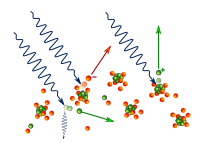Compton effect

Picture the Olympics, where you may have seen athletes doing gymnastics and flips. When they do a flip, they spin and land on their feet. This spinning is just like how electrons in atoms spin around their nucleus, which is kind of like the atom's center.
Now imagine that an electron in an atom is sitting still when suddenly, it gets hit by light or a photon. This photon can give the electron energy, and just like an athlete, the electron can start to spin faster.
But here’s where it gets interesting: when the photon hits the electron, it doesn’t bounce off like a ball would. Instead, it transfers a bit of its energy to the electron and changes direction. Think of it like a game of pool, where one ball hits another and both change direction after the collision.
This change in the photon’s direction is called the Compton Effect. It happens when high-energy X-rays, for example, collide with matter like solid objects, and part of the energy of the X-ray is transferred to the electrons of that object.
Ultimately, the Compton Effect helps us understand how photons interact with matter, which is pretty important in fields like physics and medicine where we use X-rays to see inside the body or study particles.
Now imagine that an electron in an atom is sitting still when suddenly, it gets hit by light or a photon. This photon can give the electron energy, and just like an athlete, the electron can start to spin faster.
But here’s where it gets interesting: when the photon hits the electron, it doesn’t bounce off like a ball would. Instead, it transfers a bit of its energy to the electron and changes direction. Think of it like a game of pool, where one ball hits another and both change direction after the collision.
This change in the photon’s direction is called the Compton Effect. It happens when high-energy X-rays, for example, collide with matter like solid objects, and part of the energy of the X-ray is transferred to the electrons of that object.
Ultimately, the Compton Effect helps us understand how photons interact with matter, which is pretty important in fields like physics and medicine where we use X-rays to see inside the body or study particles.
Related topics others have asked about:
Compton Gamma Ray Observatory,
Klein–Nishina formula,
Non-linear inverse Compton scattering,
Nuclear electromagnetic pulse,
Pair production,
Peter Debye,
Photoelectric effect,
Radiation pressure,
Resonant inelastic X-ray scattering,
Thomson scattering,
Timeline of cosmic microwave background astronomy
